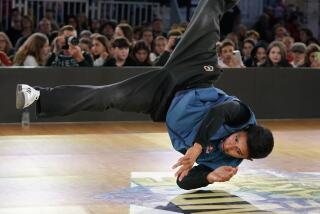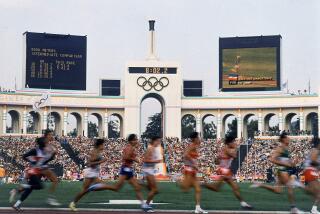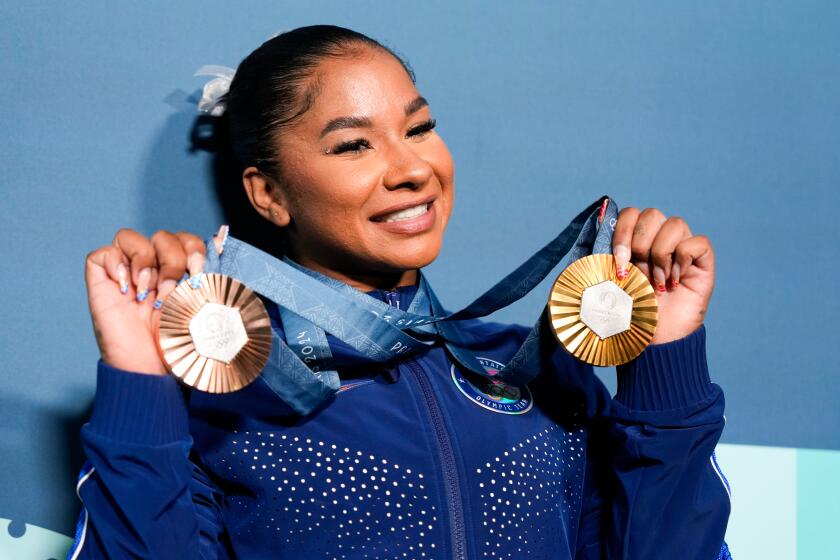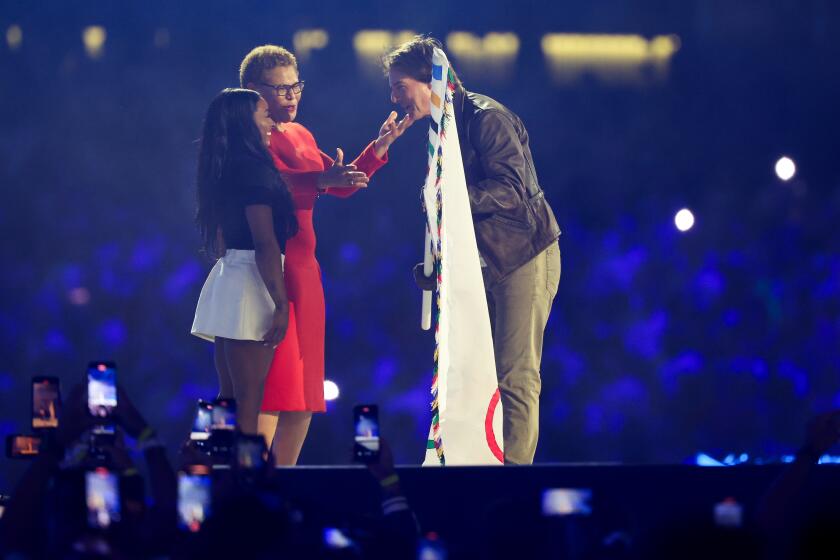A Weighty Sport and a Light Impression
Every few minutes, a clanging crash dispels the evening quiet around the cul-de-sac in San Jacinto in Riverside County. The noise comes from a lighted open garage at 351 Quince Drive, where, amid plastic bottles of gopher mix and car wax, Greg Schouten works on his world-class ambition.
Coach Pat Cullen-Carroll, the homeowner at 351 Quince, watches as Schouten leans forward from the waist, flexing his hands. Before him on the makeshift plywood platform is a York barbell weighted at 253 1/2 pounds. Schouten takes the bar in hand. With a quiet expulsion of breath and in one motion, he heaves it to the tops of his thighs, dips to a squat and snaps it above his head. Holding the bar aloft with straight, outward-angling arms, he rises to a standing position, completing a perfect snatch. Then he steps back and lets go of the bar. Blang!
Schouten is 25, 5 foot 9, with a blond crew cut and shadow beard. A part-time football and track coach at San Jacinto High, he is also the sixth-ranked Olympic-style weightlifter in the United States.
The 253 1/2 pounds on the bar is merely his maximum workout weight for the night. In competition, he has snatched 314 pounds, and intends by the 2004 Olympics to have worked up to something like 357 pounds.
The snatch is one of two events that constitute Olympic weightlifting, the only strength sport in the Games. The other is the clean-and-jerk, in which the lifter raises a bar to chin level as he squats, stands up, then scissor-kicks to a split stance beneath the bar, raising it above his head and finally bringing his feet together to stand erect. In competition, Schouten has clean-and-jerked 364 pounds and is intent on 423 pounds by the Olympics.
He himself weighs 170.
To cognoscenti, the term “weightlifters” applies only to Olympic-stylers, not to powerlifters (whose events are the squat, dead lift and bench press) or, heaven forbid, bodybuilders. For serious weightlifters, everything points to the Olympics, the sport’s quadrennial parole from obscurity. There are no intercollegiate weightlifting competitions, no scholarships, no professional tour.
In the United States, this lack of reward has meant a chronic shortage of athletes and coaches and, thus, slender Olympic fortunes for a generation. Los Angeles, for example, has but one true weightlifters gym. “Most fitness centers do not like to have Olympic lifters in their facility,” says Paul Fleschler, technical director of USA Weightlifting Federation. “They make a lot of noise, because the weights are made to be dropped from overhead. Also, fitness centers cater to people who primarily care about how they look. Most of the athletes don’t care much what they look like, they just want to be able to lift a lot of weight.”
The L.A. gym is at Van Nuys High School. It is the domain of master weightlifting coach Bob Takano. Gym and coach are well known within the small world of weightlifting, and exemplify its ethic of sacrifice.
The barn-like facility, gritty, scarred and devoid of amenities, is “very much like the training center for the Bulgarian national team,” Takano says.
Takano, 54, has coached the U.S. women’s team in the world weightlifting championships, and will be an assistant coach of the men’s team in this year’s competition in Poland. He teaches advanced-placement biology and honors physiology at Van Nuys High. From 3:30 to at least 8 weeknights, and all afternoon Saturday, he can be found in the gym, working with high-schoolers and competitive adult weightlifters. “I guess I don’t have a private life,” he admits. “But there are so very few of us who know how to do this. I have to keep the torch going. If I don’t, there’s no weightlifting in L.A. There is none in Chicago now. There’s no weightlifting in Dallas. In many big cities there’s no weightlifting at all. It’s amazing we have the Olympic team we do.”
What fires the sport’s devotees is its deceptive sweetness, its commingling of strength, speed, agility and precision. To them, it’s addictive. “When you do a perfect lift, the bar is almost weightless,” says Arthur Drechsler, author of the seminal “The Weightlifting Encyclopedia. “It’s like hitting the sweet spot in golf, and once you experience it, you want to experience it again and again.”
I have a hunch of my own about why weightlifters are so overlooked in image-crazy Southern California: Their bodies don’t resemble those that strut in front of tourists at Muscle Beach. The puffed narcissists of bodybuilding define our visual notions of strength. Weightlifters are the strongest people in the world, but they tend to look much like athletes in other competitive sports. Greg Schouten, for example, could pass for a college-football defensive back.
In short, another example of the special L.A. tendency to confuse appearance with substance. Diana Fuhrman, a Van Nuys High teacher and former student of Takano, often hears people remark, after they learn of her three national women’s weightlifting championships, “You don’t look that strong.” She always tells them, “This is what strong looks like.”
More to Read
Go beyond the scoreboard
Get the latest on L.A.'s teams in the daily Sports Report newsletter.
You may occasionally receive promotional content from the Los Angeles Times.








